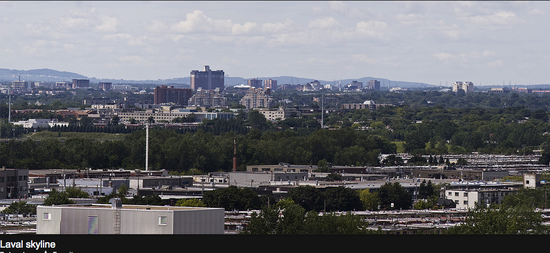Laval, A City?

Image source: Flickr, Laval.
So, for some unknown reason, you find yourself in Laval, and for plain entertainment you call yourself a cab to illustrate a point. The taxi driver asks you for your destination, and you simply reply: "Downtown please". Intrigued, the driver frowns and responds: "Pardon me sir?" This awkward situation explains itself by the uncontestable fact that Laval has no center. Thus, there isn't any "downtown" to be brought to. In the past years, I have traveled in Europe and all over North America, and visiting cities is really my cup of tea. For instance, it's always interesting to see how cultural trends and architectural masterpieces emerge from urban centers such as Los Angeles, Seattle, Toronto, Paris or even Vancouver. Now, if we think of these "real" cities around the world, isn't it true that they are all built around a core center? Wouldn't this hub be one of the main conditions when attributing a "city" status to a given area? When comparing Montreal and Laval, it is easy to realize that the latter is not a city: Laval is an outer core with no core.
Although Montreal and Laval differ in many ways, they still share particular characteristics common to all cities. In both areas, we can find a town hall with elected officials, a public transportation system, entertainment and recreational activities, retail stores to serve the residents' needs, and industrial parks. However, a more valid element to consider in qualifying as a city is population density. Montreal reaches almost two million residents. This makes it the most populated city in the province of Québec. In contrast, yet still respectful, Laval with almost 400 thousand residents - when regrouping all of its agglomerations - meets the requirements in achieving a city status since it even exceeds the arbitrary amount required. Furthermore, in terms of importance (population-wise) Laval is the third largest municipality in the province. Nevertheless, though Laval is a high densely populated area just like Montreal is, other factors must be considered when attributing the city rank.
Another important aspect, the population's daily activities, truly demonstrates contrastive behaviors between Montreal and Laval residents. Most Montrealers live and work in their city. By contrast, Laval citizens ("Lavalers") tend to spend most of their time in Montreal. They work in the city and use their hometown as a dormitory. This being the case, we can consider Laval to be a bedroom community or dormitory town. In fact, these two commonly used expressions take root from what is called a commuter town; urban community which is mostly residential and where residents sleep before going to work elsewhere the next day. Commuter towns are more than often linked through railway, subway, or bus systems to bigger cities where workers are transported to areas where commercial and industrial activity takes place. Now, doesn't that ring a bell? Yes, Laval is actually one of Montreal's commuter towns. No wonder it has no center, or in other terms, a "downtown". It wasn't meant to be a city.
Of all cities I have been to, all had a particular observable feature, which could be noticed by a glimpse of the eye. Accordingly, Montreal has this discernible trait. Vertically built, Montreal's hub can be seen many kilometers away. Its skyscraper silhouette magnificently illuminated at night, dangerous to drivers who eyeball it for too long, yet almost invisible on grey smoggy days, but still always vibrant and vivacious, truly offers a spectacular and appealing view. The observer, attracted by its architectural beauty, is tempted to discover its insides. The culturally diverse uniqueness of Montreal is something, which only a city can offer. In contrast, Laval is nowhere close to being city-like, with its bland flattened shape, eclipsed from the horizon, disappeared, darkened by night, and sprawled from something it is not.
Laval's eligibility into "city hood" being discredited may affect Lavalers' ego since being termed a city carries a prestige of its own. The fact of the matter is that a population's collective identity also revolves - amongst other factors - around its location. This being said, Lavalers must now accept the heartbreaking reality of not being considered a city. Sincerely, I'm not one of those etymology (study of word origins) freaks, who constantly needs to precisely label everything. Yet, when I hear Laval city, it just irritates me. As seen from the contrasted ideas above, Laval cannot be catalogued as a city, and thereby remains a bedroom community. Thus, it is only in sound that it can even come close to its intended status: Laval C.T.; referring to Commuter Town.

Leave a comment